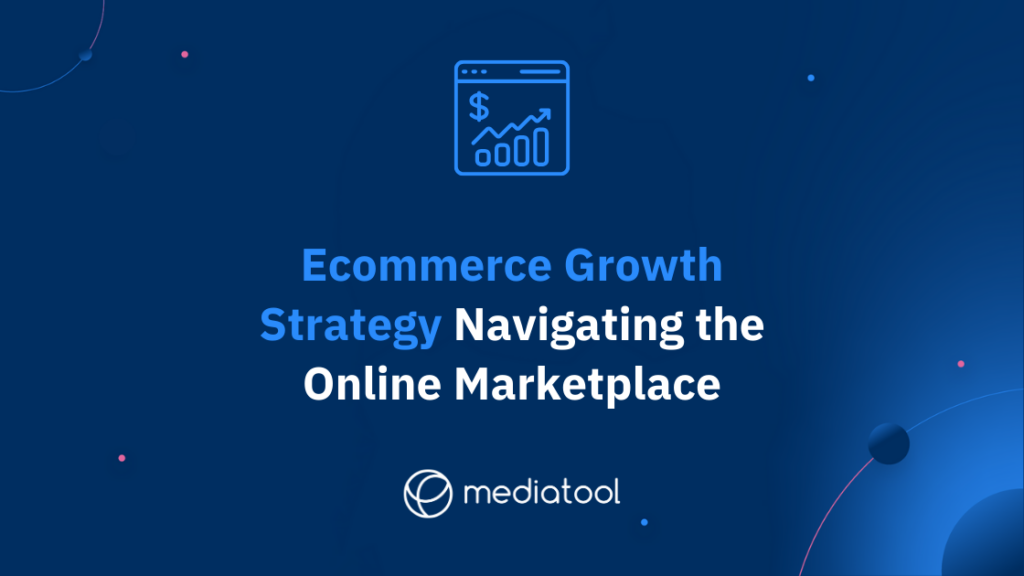In the competitive world of online retail, establishing a robust ecommerce growth strategy is not just beneficial—it’s essential.
Many ecommerce businesses encounter the challenge of standing out in a crowded and dynamic digital marketplace.
With an ever-increasing number of online stores vying for attention, the absence of a well-defined growth strategy can leave an ecommerce business struggling to find its footing.
The issue is multifaceted:
- understanding the diverse needs of potential customers,
- effectively reaching and engaging them,
- and turning them into loyal patrons.
Additionally, the rapid pace of technological advancements and changing consumer behaviors make it imperative for e-commerce businesses to adapt quickly and intelligently.
To tackle these challenges, a well-crafted ecommerce growth strategy is key to make informed decisions, optimize operations, and achieve sustainable growth in a highly competitive online environment.
What Is An Ecommerce Growth Strategy?
An e-commerce growth strategy is essential for success in the online market. It’s a detailed approach to guide your ecommerce business through the various aspects of the digital marketplace.
This strategy covers everything from identifying your target customers to creating an outstanding customer experience. It aims to turn your online store into a go-to destination for shoppers, where they find what they need and enjoy the experience so much that they keep coming back.
Why Are Ecommerce Growth Strategies Important?
Let’s face it: the e-commerce playground is vast and ever-changing. An effective e-commerce growth strategy guides your online store toward success, helping you adapt to ever-evolving market trends and outperform competitors.
This strategy is the cornerstone of e-commerce success, ensuring your e-commerce website doesn’t just blend into the background but stands out in the digital marketplace. It’s about enhancing every aspect of your e-commerce business strategy, from refining your e-commerce marketing strategy to optimizing your e-commerce site for a superior customer experience.
This holistic approach to ecommerce strategies focuses on understanding and catering to both potential and existing customers’ needs, fostering customer loyalty, and driving repeat business.
A well-crafted ecommerce growth strategy pays close attention to the customer journey, aiming to create seamless and memorable experiences for online shoppers. It’s about understanding your target market and tailoring your offerings to meet their expectations, from the product line to shipping options like free shipping thresholds. This approach boosts sales and builds a solid customer base, essential for long-term e-commerce success.
How to Develop an eCommerce Growth Strategy

Crafting a successful ecommerce growth strategy is less about complexity and more about a deep understanding of your market and customers. It’s a strategic process that involves several key steps to ensure your e-commerce business, whether an e-commerce store or a comprehensive online marketplace, thrives in today’s digital economy.
Identifying Your Target Market
The first step in formulating an effective ecommerce strategy is pinpointing your target customers.
Are they savvy online shoppers looking for the latest trends or value-driven consumers seeking the best deals?
Recognizing their unique needs and preferences is crucial for tailoring your ecommerce marketing strategy. This understanding helps create targeted marketing campaigns on social media platforms, enhance your ecommerce website’s customer journey, and ultimately drive more sales.
Analyzing Your Competitors
Keeping a close watch on your competition is key to defining your ecommerce business strategy. Analyze their tactics, from social media marketing to customer loyalty programs, and learn from their successes and missteps.
This insight helps shape your e-commerce strategies, differentiate your brand, and create a unique value proposition for your e-commerce brand.
Setting Goals and KPIs
Developing clear, achievable goals and key performance indicators (KPIs) is essential for measuring the effectiveness of your ecommerce growth strategy. Whether boosting website traffic, increasing customer retention, or enhancing the overall customer experience, these goals provide a benchmark for success.
Setting targets related to increasing online sales, expanding your customer base, or improving product line visibility ensures that your ecommerce store remains focused and driven toward e-commerce success.
Each step in developing an ecommerce growth strategy contributes to building a robust and holistic approach to growing your online business. From leveraging email marketing to engage existing customers to utilize influencer marketing to attract new customers, every aspect of your strategy should be aligned with your overall business objectives.
Remember, a great e-commerce strategy is not just about selling products; it’s about creating a memorable brand experience, fostering loyal customers, and achieving long-term success in the competitive world of e-commerce.
10 Ecommerce Growth Strategies You Can Use
Leverage Social Media Marketing
Embracing social media marketing is a game-changer for ecommerce businesses. Use platforms like Instagram, Facebook, and X (Twitter) to engage potential and existing customers. Create compelling content, run targeted ads, and interact with your audience.
This approach boosts your online presence and drives traffic to your ecommerce website, helping increase sales and customer loyalty.
Additionally, consider using live streaming and interactive features like polls and Q&A sessions to deepen engagement. These tactics can provide real-time feedback and foster a sense of community among your customers.
Focus on Customer Experience
A stellar customer experience is key to the success of your online store. Ensure your ecommerce site is user-friendly with easy navigation, fast loading times, and responsive design.
Providing a smooth shopping experience, from browsing product pages to checking out, can significantly enhance customer retention and encourage repeat purchases.
Don’t overlook the power of personalization. Use customer data to offer personalized recommendations and a customized shopping experience. This can make customers feel valued and increase their likelihood to return.
Importantly, 90% of businesses across various industries have recognized the importance of customer experience, making it their top priority. This trend underscores the critical role of customer experience in achieving success in the online marketplace.
Optimize for Search Engines
Search engine optimization (SEO) is necessary for increasing your ecommerce website’s visibility. Use relevant keywords, optimize product descriptions, and ensure your site is mobile-friendly.
High search engine rankings lead to more website traffic and, subsequently, more online sales.
Consider incorporating local SEO strategies if you have a physical store or target specific geographic areas. This can help attract local customers and drive both online and offline traffic.
Create Engaging Content
Developing engaging content, such as informative blog posts, how-to guides, and captivating product videos, can attract and retain customers.
This strategy not only informs your target audience but also establishes your ecommerce brand as a credible and authoritative source in your niche.
Explore different content formats like podcasts, webinars, and interactive infographics to reach a broader audience. Diverse content types can cater to different preferences, keeping your brand fresh and exciting.
Email Marketing
Utilize email marketing to keep in touch with your customer base. Send personalized emails with exclusive discounts, product updates, and valuable content.
This direct communication can effectively boost customer loyalty and drive repeat business.
Implement segmentation and automation in your email marketing strategy. Targeted emails based on customer behavior and purchase history can significantly increase open rates and conversions.
In fact, emails that are segmented have been shown to achieve 30% higher open rates and 50% more click-throughs compared to non-segmented ones, highlighting the effectiveness of a targeted approach in your email marketing efforts.
Customer Retention Programs
Implement customer retention programs to reward loyal customers. Offer loyalty points, discount codes, and exclusive promotions to encourage repeat purchases and turn customers into loyal brand ambassadors for your ecommerce brand.
Create a tiered loyalty program that rewards customers based on their level of engagement or spending. This can incentivize higher spending and more frequent purchases.
Utilize User-Generated Content
Encourage customers to share their experiences by posting reviews, photos, and testimonials. User-generated content adds authenticity to your brand and can influence the purchasing decisions of new customers, boosting your ecommerce success.
Organize contests or campaigns encouraging user-generated content, such as photo contests or hashtag campaigns. This can increase engagement and provide you with valuable content for marketing purposes.
Advertising that incorporates user-generated content can lead to a remarkable 400% increase in click-through rates, showcasing the powerful impact of leveraging authentic customer experiences in your marketing strategies.
Refine Your Product Line
Regularly assess and update your product line to align with current market trends and customer preferences. Offering a relevant and diverse range of products can attract a wider audience and cater to the varied needs of your target market.
Use customer feedback and market research to identify new products or enhancements. Staying responsive to customer needs can help you stay ahead of market trends.
Influencer Marketing
Partner with influencers who share your brand values and resonate with your target audience. Influencer marketing can help you reach new customers, build brand credibility, and increase online sales through social media channels and other digital platforms.
Look beyond traditional influencers and consider partnering with micro-influencers or niche bloggers. They often have highly engaged audiences and can provide more authentic promotion for your brand.
It’s worth noting that around 25% of brands globally allocate 10-20% of their marketing budget to influencer marketing, indicating its growing importance in the digital marketing landscape.
Analyze and Adapt
Regularly analyze your ecommerce strategies using analytics data. Track website traffic, customer behavior, and sales patterns. Use these insights to adapt and refine your marketing campaigns, ensuring your ecommerce business stays ahead in a competitive market.
Don’t just focus on short-term data. Analyze long-term trends and seasonality to inform your strategic planning. This can help you anticipate changes in customer behavior and market conditions, allowing you to adapt proactively.
Harnessing Media Data for Ecommerce Growth: The Key to Data-Driven Decision Making

In the rapidly evolving world of ecommerce, leveraging media data is not just an option; it’s a necessity for growth and sustainability. Media data encompasses a wide array of information derived from your marketing efforts, including data from social media channels, online advertising, email campaigns, and more.
It’s the cornerstone of understanding your customers’ behaviors, preferences, and the effectiveness of your marketing strategies.
Understanding Customer Behavior
Media data provides invaluable insights into customer behavior and engagement. Ecommerce businesses can understand how customers interact with their brand online by analyzing data from various channels.
This includes which social media posts are most engaging, what type of content drives the most traffic, and which email marketing strategies are most effective. Understanding these dynamics is crucial for refining marketing approaches and enhancing customer experience.
Measuring Campaign Effectiveness
One of the primary benefits of media data is its ability to measure the effectiveness of marketing campaigns. Ecommerce brands can track metrics such as click-through rates, conversion rates, and return on advertising spend (ROAS).
This data helps identify which campaigns are performing well and which need adjustment, allowing for more targeted and cost-efficient marketing strategies.
Optimizing Marketing Spend
Allocating marketing budgets effectively is critical for ecommerce success. Media data helps in identifying which channels and campaigns yield the best returns.
This enables ecommerce companies to optimize their marketing spend, focusing on the most profitable avenues and cutting back on those not delivering desired results.
Enhancing Customer Targeting
With media data, ecommerce businesses can segment their audience more effectively and tailor their marketing messages. Companies can create personalized and relevant marketing campaigns by understanding the demographics, interests, and behaviors of their target market.
This level of targeting improves customer engagement and increases the likelihood of conversions and sales.
Predicting Future Trends
Media data also plays a key role in predicting future market trends and customer preferences. By analyzing historical data and current market conditions, ecommerce businesses can anticipate changes in consumer behavior and adapt their strategies accordingly.
This proactive approach is essential for staying ahead in a competitive market.
Mediatool: Enhancing Ecommerce Success with Media Data
Mediatool offers a comprehensive solution for ecommerce businesses looking to harness media data for growth and competitiveness. Mediatool centralizes media data from various marketing channels, providing a unified dashboard for a clear view of all your campaigns in the same place.
Mediatool enables you to make smarter media investment decisions by identifying your most successful marketing channels and campaigns.
Looking for more ways to get an edge against the competition? Take a tour of Mediatool today and see how to efficiently and effectively plan, track, and report on all your media.
Conclusion
In wrapping up, it’s clear that a strong ecommerce growth strategy is essential for any online business looking to stand out and succeed. This strategy isn’t just about selling products; it’s about understanding your customers, creating a great shopping experience, and building a brand people trust and return to.
The journey to a successful ecommerce strategy might seem challenging, but it’s achievable. Businesses can make smarter decisions, connect with customers more effectively, and keep growing by using tools like social media marketing and platforms like Mediatool for media data analysis.
So, remember: ecommerce success is all about adapting, understanding your customers, and constantly improving your approach. With the right strategy in place, your online business can thrive in the competitive world of ecommerce.





